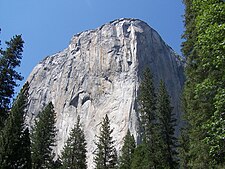User:Cullen328/sandbox/Merry
Wayne Merry, born Wayne Procter White (1931-2019) was an American rock climber, mountaineer and National Park Service ranger.
In 1958, Merry was one of a team of three members of a team of climbers led by Warren Harding that completed the first ascent of a 2,900 feet (880 m) high vertical face of El Capitan in Yosemite Valley.
Early life[edit]
Merry was born in Fresno, California on August 4, 1931, to Sarah Louise Procter and Harold White. His mother later remarried, and Wayne took the last name of his stepfather, Ralph Merry. He spent most of his childhood in Calistoga, California, and graduated from high school there.
After a brief time attending college, he enlisted in the United States Navy at the beginning of the Korean War, and was trained as a dental technician.
While stationed in San Diego, he joined the Sierra Club and became active in its Rock Climbing Section.
Merry left the Navy in 1956, and then studied conservation at San Jose State University, earning a degree in conservation in 1959. He married Barrison the same year
Climbing career[edit]

In 1957, rock climber Warren Harding set his sights on a massive unclimbed face, the 2,900 feet (900 m) prow of El Capitan in Yosemite Valley. Previously, the almost vertical faces of El Capitan had been widely considered as unclimbable. Merry was not yet involved with this climb. With Mark Powell and Bill "Dolt" Feuerer, Harding began the climb in July 1957. Rather than follow the single-push "alpine" style of climbing, they were forced, given the technology of the day, to fix lines between "camps" in the style used in the Himalaya. Attempting to get half way on the first push, they were foiled by the large, 2-3" cracks, and Feuerer was required to form new rock spikes or pitons by cutting off the legs of wood stoves. This gave the name to the crack system leading to the half way point, the "stove leg cracks".
Compelled by the National Park Service to stop until March, due to the crowds forming in El Capitan meadows to watch them, they complied. As soon as the snow melted, the team had a major setback when Powell suffered a compound leg fracture on another climbing trip. Powell dropped out, and Feuerer became disillusioned. Harding, true to his legendary endurance and willingness to find new partners, "continued", as he later put it, "with whatever 'qualified' climbers I could con into this rather unpromising venture."[2] Feuerer stayed on as technical advisor, even constructing a bicycle wheeled cart which could be hauled up to the half-way ledge which bears his name today, "Dolt Tower"; but Wayne Merry, George Whitmore, and Rich Calderwood now became the main team, with Merry sharing lead climbing chores with Harding.
In the fall, two more pushes got them to the 2,000 feet (600 m) level. Finally, a fourth push starting in the late fall would likely be the last of the year. The team had originally fixed their route with 1⁄2 inch (13 mm) manila lines, and their in situ lines would have weakened dangerously over the winter. In the cooling November environment, they worked their way slowly upward, with the seven days it took to push to within the last 300 feet (100 m) blurring into a "monotonous grind" if, Harding adds, "living and working 2500 feet above the ground on a granite face" could be considered monotonous.[2] After sitting out a storm for three days at this level, they hammered their way up the final portion. Harding struggled fifteen hours through the night, hand-placing 28 expansion bolts up an overhanging headwall before topping out at 6 AM. The complete climb had taken 45 days, with more than 3,400 feet (1,000 m) of climbing including huge pendulum swings across the face, the labor of hauling bags, and rappel descents.
The team had finished what is, by any standard, one of the classics of modern rock climbing.
- ^ Slotnick, Daniel E. (December 3, 2019). "Wayne Merry, Climber Who Conquered El Capitan, Dies at 88: In 1958 he and two others became the first to scale a 2,900-foot granite wall in Yosemite National Park in California that many considered practically unclimbable". New York Times. Retrieved October 24, 2022.
- ^ a b Warren Harding (1959). "El Capitan" (PDF). American Alpine Journal.
- ^ Grossman, Steve (January 9, 2020). "Wayne Merry (1931-2019): Yosemite legend, teacher and loving steward of wild places". Alpinist. Retrieved October 24, 2022.
- ^ Roper, Steve; Steck, Allen (1979). Fifty Classic Climbs of North America. Sierra Club Books. pp. 261–267. ISBN 9780871562920.
